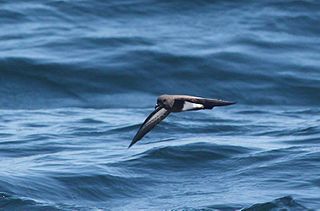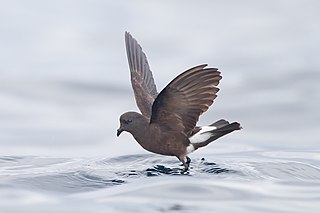 W
WThe Antarctic fur seal, is one of eight seals in the genus Arctocephalus, and one of nine fur seals in the subfamily Arctocephalinae. Despite what its name suggests, the Antarctic fur seal is mostly distributed in Subantarctic islands and its scientific name is thought to have come from the German vessel SMS Gazelle, which was the first to collect specimens of this species from Kerguelen Islands.
 W
WArctocephalus forsteri is a species of fur seal found mainly around southern Australia and New Zealand. The name New Zealand fur seal is used by English speakers in New Zealand; kekeno is used in the Māori language. As of 2014, the common name long-nosed fur seal has been proposed for the population of seals inhabiting Australia.
 W
WThe Birds of Macquarie Island are, unsurprisingly for an isolated oceanic island, predominantly seabirds. By far the majority of the breeding species are penguins, petrels and albatrosses. However, the bird list includes many vagrants, including passerines, from New Zealand and Australia.
 W
WThe southern elephant seal is one of the two species of elephant seals. It is the largest member of the clade Pinnipedia and the order Carnivora, as well as the largest extant marine mammal that is not a cetacean. It gets its name from its massive size and the large proboscis of the adult male, which is used to produce very loud roars, especially during the breeding season. A bull southern elephant seal is about 40% heavier than a male northern elephant seal, more than twice as heavy as a male walrus, and 6–7 times heavier than the largest living terrestrial carnivorans, the polar bear and the Kodiak bear.
 W
WThe subantarctic fur seal is found in the southern parts of the Indian, Pacific, and Atlantic Oceans. It was first described by Gray in 1872 from a specimen recovered in northern Australia—hence the inappropriate specific name tropicalis.
 W
WThe kelp gull, also known as the Dominican gull, is a gull that breeds on coasts and islands through much of the Southern Hemisphere. The nominate L. d. dominicanus is the subspecies found around South America, parts of Australia, and New Zealand. L. d. vetula is a subspecies occurring around Southern Africa.
 W
WThe king penguin is the second largest species of penguin, smaller, but somewhat similar in appearance to the emperor penguin. There are two subspecies: A. p. patagonicus and A. p. halli; patagonicus is found in the South Atlantic and halli in the South Indian Ocean and at Macquarie Island.
 W
WThis is a list of the bird species recorded in the Prince Edward Islands. The Prince Edward Islands, c. 1,750 km offshore in the Roaring Forties, are near-pristine and deemed the second most important sub-Antarctic archipelago in terms of breeding birds.
 W
WThe chinstrap penguin is a species of penguin that inhabits a variety of islands and shores in the Southern Pacific and the Antarctic Oceans. Its name stems from the narrow black band under its head, which makes it appear as if it were wearing a black helmet, making it easy to identify. Other common names include ringed penguin, bearded penguin, and stonecracker penguin, due to its loud, harsh call.
 W
WThe gentoo penguin is a penguin species in the genus Pygoscelis, most closely related to the Adélie penguin and the chinstrap penguin. The earliest scientific description was made in 1781 by Johann Reinhold Forster with a type locality in the Falkland Islands. They call in a variety of ways, but the most frequently heard is a loud trumpeting which the bird emits with its head thrown back.
 W
WThe royal penguin is a subspecies of penguin, which can be found on the sub-Antarctic Macquarie Island and adjacent islands. It is a localised variant of the Macaroni penguin. The International Union for Conservation of Nature (IUCN) classifies the royal penguin as near threatened. The scientific name commemorates the German zoologist Hermann Schlegel.
 W
WThe Cape petrel, also called the Cape pigeon, pintado petrel, or Cape fulmar, is a common seabird of the Southern Ocean from the family Procellariidae. It is the only member of the genus Daption, and is allied to the fulmarine petrels, and the giant petrels. They are extremely common seabirds with an estimated population of around 2 million.
 W
WThe snow petrel is the only member of the genus Pagodroma. It is one of only three birds that has been seen at the Geographic South Pole, along with the antarctic petrel and the south polar skua, which have the most southerly breeding sites of any bird, inland in Antarctica.
 W
WThe black-bellied storm petrel is a species of seabird in the family Oceanitidae.
 W
WThe grey-backed storm petrel is a species of seabird in the austral storm petrel family Oceanitidae. It is monotypic within the genus Garrodia. It is found in Antarctica, Argentina, Australia, Chile, Falkland Islands, French Southern Territories, New Zealand, Saint Helena, South Africa, and South Georgia and the South Sandwich Islands. Its natural habitat is open seas.
 W
WWilson's storm petrel, also known as Wilson's petrel, is a small seabird of the austral storm petrel family Oceanitidae. It is one of the most abundant bird species in the world and has a circumpolar distribution mainly in the seas of the southern hemisphere but extending northwards during the summer of the northern hemisphere. The world population has been estimated to be more than 50 million pairs. The name commemorates the Scottish-American ornithologist Alexander Wilson. The genus name Oceanites refers to the mythical Oceanids, the three thousand daughters of Tethys. The species name is from Latin oceanus, "ocean".